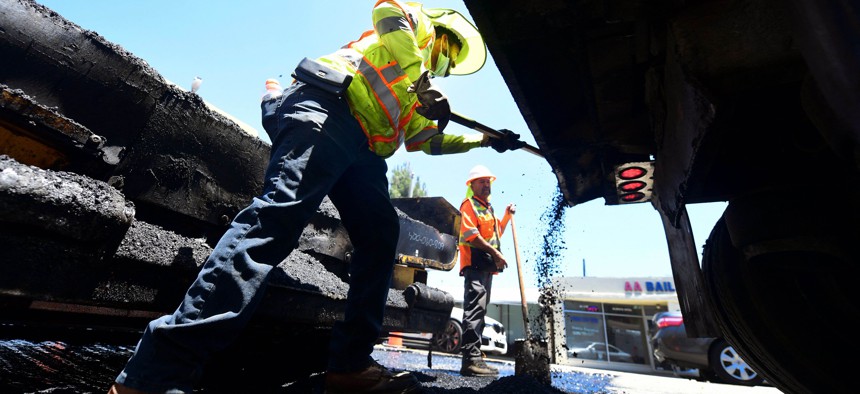Tips for Winning Federal Transportation Grants

A roadworks crew work on road resurfacing on June 24, 2021 in Alhambra, California. Frederic J. Brown/AFP via Getty Images
A Biden administration official had some advice for city leaders seeking funding for projects under the latest federal infrastructure law.
A top Biden administration transportation official offered mayors tips for how to secure some of the billions of dollars in grants available to their cities under the federal infrastructure law.
Christopher Coes, the assistant secretary for transportation policy at the U.S. Department of Transportation, encouraged the city leaders to show how their plans for spending the grants would improve racial equity and address other top priorities of the Democratic administration.
Taking racial equity and climate change into consideration have been the “invisible hand within the [transportation] department but also across our sister agencies,” Coes told officials at the U.S. Conference of Mayors annual winter meeting in Washington, D.C. last week. President Biden signed executive orders that established those priorities on his first day in office, Coes noted.
One example of how that has guided the administration’s decisions on grant applications, he said, was the distribution of RAISE grants, which fund improvements for different transportation modes and the handling of freight.
About 58% of the communities that won those grants were in historically disadvantaged places, he said. If you add rural areas, the level increased to 78%, he noted.
Localities can boost their chances of getting transportation grants by showing how they would further the administration’s priorities, Coes said. He offered a few examples:
Developing projects that benefit ‘Justice 40’ communities. While other federal agencies have previously designated areas that were disadvantaged in terms of health or environmental conditions, the Transportation Department only recently designated places where residents faced “transportation insecurity,” Coes said. In those areas, residents had no easy way to get to jobs and other destinations, lacked access to transit and walking infrastructure, and faced high levels of pollution.
Now that the Transportation Department has identified those areas, it plans on directing 40% of the benefits from its discretionary grants to those “Justice 40” communities, in line with the Biden administration’s overall goals.
Cities should make sure they include those census tracts in their plans for federal money, Coes said.
“When we see an application, we are asking you to prioritize those communities,” he said. “We want to hear from applicants how you’re planning to eliminate those harms or those disadvantages over the life of the application. The goal here is that those Justice 40 communities will become thriving communities.”
Prioritize public engagement. The federal Transportation Department released a document in October about ways to improve the process of getting public input about projects. Coes told the mayors that agency officials will look for meaningful community engagement, not just in determining what the project will look like, but in how it will be delivered. The federal officials, for example, will be looking for the potential for women- and minority-owned businesses to be involved in construction.
Look to the private sector. In response to a question about rural mobility, Coes said he was encouraged by partnerships between communities and private companies that can provide on-demand service. “This can’t just be about fixed guideway systems. It’s really about how you get people to their everyday destinations,” he said.
Make roads safer. A year ago, the Transportation Department released a national strategy to respond to the surge in traffic deaths in recent years. Coes said he expects local governments to start implementing those ideas. “If your local community has not signed up to commit to specific acts as to how we can reduce our road fatalities, trust me, I’m watching,” he told the mayors.
Don’t wait to ask for funding for transit-oriented development. With a nationwide housing shortage spurring local and state governments to make it easier to build homes, many have focused on the possibility of building more homes near rail and bus stops. Coes said that local officials with ideas about how to do that should not be waiting for a formal notice of funding opportunity from the federal government.
“You can just literally come in if you have a transit-oriented development project,” he said. “We are authorized as part of the bipartisan infrastructure law to provide you direct loans for your mixed-income or affordable housing projects near those transit stations as well as passenger rail stations,” he said. The agency’s Build America Bureau, he said, is “trying to build a new pipeline” of transit-oriented development projects.
Be specific in applications for electric vehicle chargers. The Transportation Department will release its notice of funding opportunity for local communities to build electric vehicle chargers “in a couple of weeks,” Coes said.
The 2021 infrastructure law included $2.5 billion for the National Electric Vehicle Infrastructure’s discretionary grant program, which is designed to help local communities expand access to chargers in rural areas, low- and moderate-income neighborhoods and communities where private parking spaces are less common.
Coes said the federal agency wants detailed information on how those grants would meet the needs of the community, and also how chargers could provide opportunities to bolster minority businesses. “Not just on the [installation] of the charger, but also the whole ecosystem,” he said.
Coes’ remarks came after Stephen Scherr, the CEO of Hertz, told mayors that the rental car company would share data with cities about its electric vehicle usage. “We share this information with cities,” he said. “We will help guide you with this data as to where cars are going. We don’t want to build charging stations where they’re not going to be used. We want to optimize the grants that are coming to you.”
Daniel C. Vock is a senior reporter for Route Fifty based in Washington, D.C.
NEXT STORY: Mayors Try to Cope With Pickleball Craze






